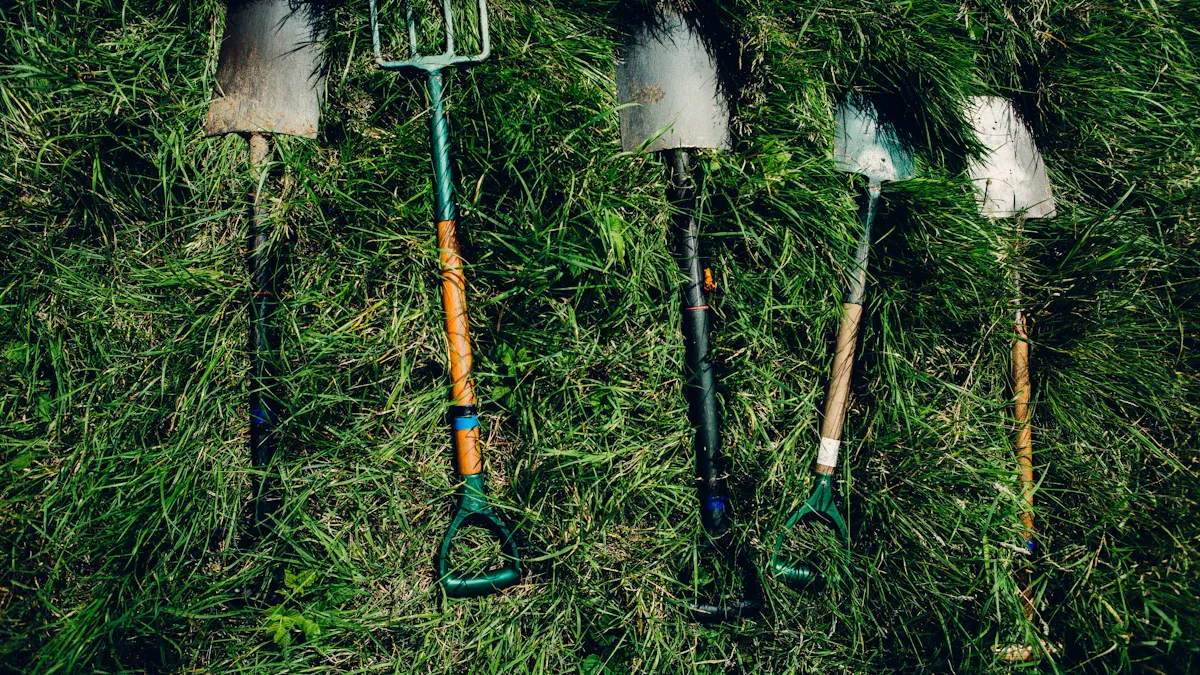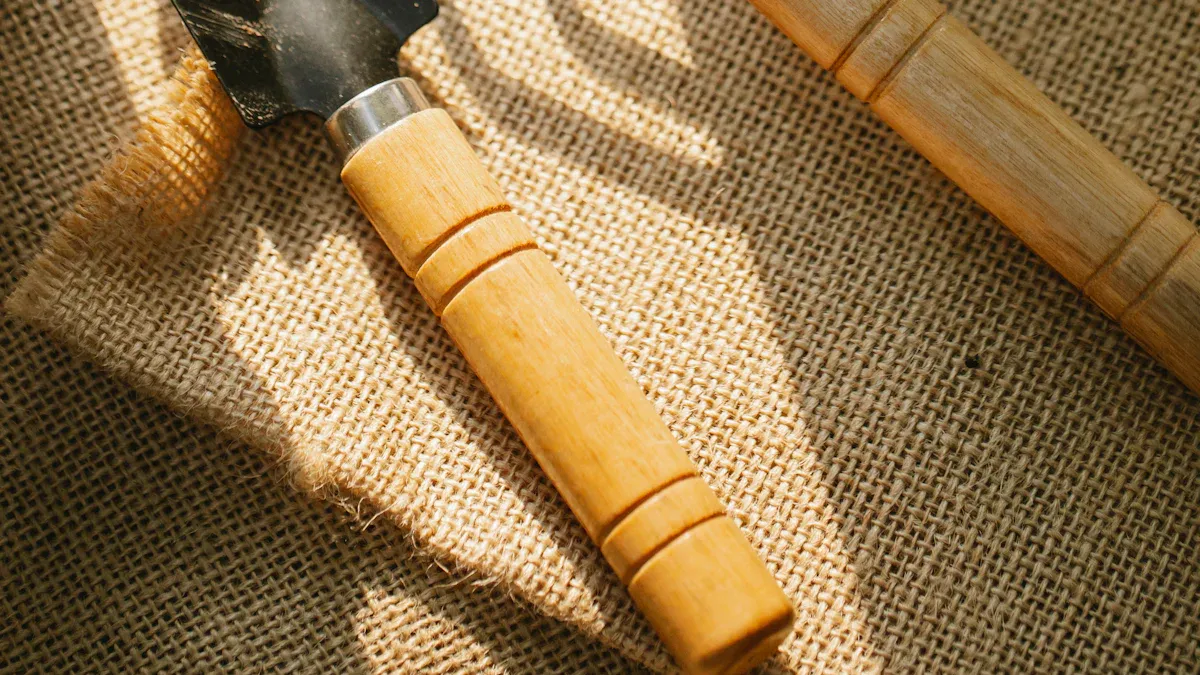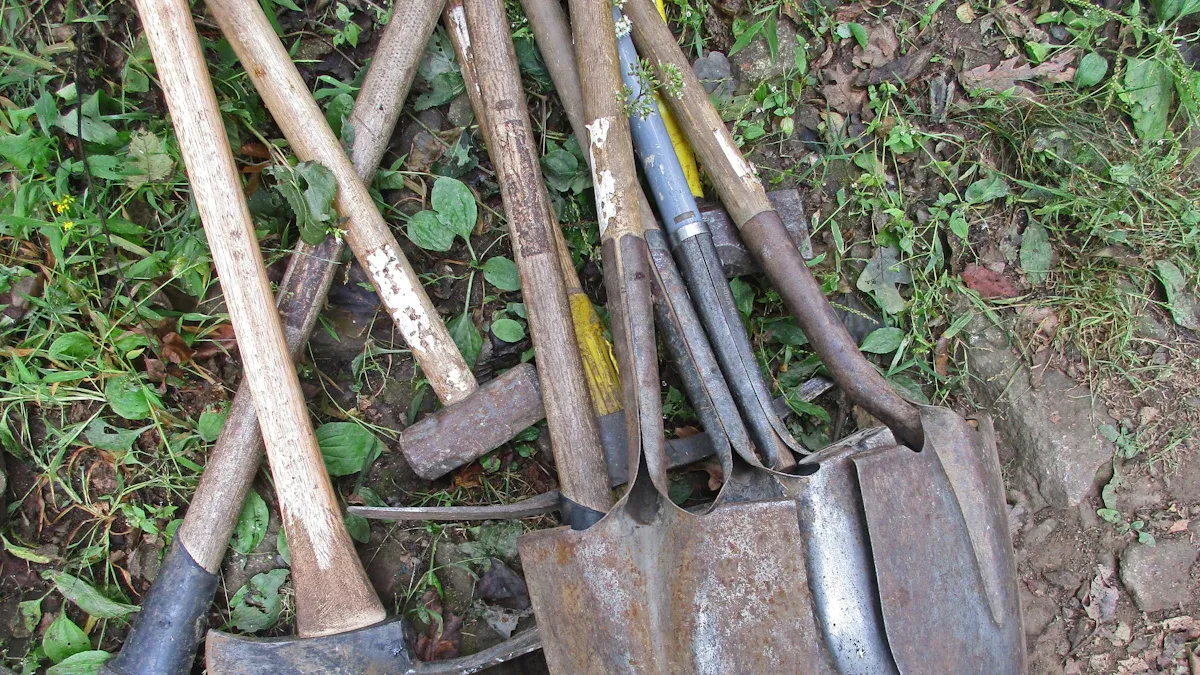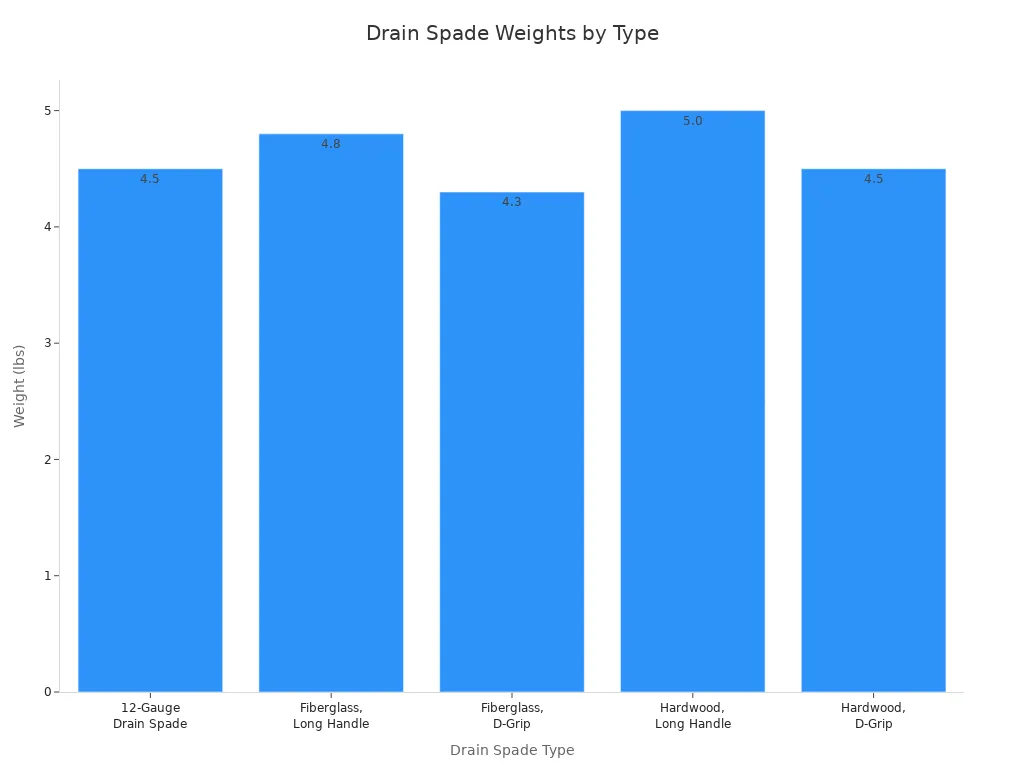
Many people underestimate the importance of using the right shovel for a task. Choosing the correct shovel can significantly save time, effort, and prevent physical strain. A single shovel does not suit every job. Different types of shovels exist for specific purposes. This blog guides readers through the diverse world of shovels. It distinguishes between specialized digging and scooping tools. This guide helps them select the perfect shovel for their needs. Every digging task requires a specific shovel.
Key Takeaways
Choosing the right shovel for a task saves time and effort.
Shovels have different parts like handles, blades, and collars, each with a special job.
Digging shovels break ground, while scooping shovels move loose materials.
Consider the task, blade material, and handle type when picking a shovel.
An ergonomic shovel design helps prevent body strain and makes work easier.
Shovel Anatomy

Understanding the parts of a shovel helps one choose the right tool. Each component plays a role in the shovel’s function and durability. A good shovel combines strong materials with ergonomic design.
Handles and Grips
A shovel’s handle provides leverage and control. Handles come in various lengths and shapes. Common types include straight handles, D-grip handles, and T-grip handles. D-grips offer a secure, two-handed hold, useful for heavy lifting. T-grips provide a single-hand grip, often seen on smaller shovels. Straight handles allow for longer reach and can be gripped anywhere along their length. Materials for handles include wood, fiberglass, and steel. Fiberglass handles are strong and lightweight. Wooden handles offer a traditional feel.
Blades: Shapes and Materials
A shovel’s blade performs the actual digging or scooping. Blade shapes vary widely for different tasks. Pointed blades penetrate hard soil easily. Square blades are good for moving loose material or scraping surfaces. Rounded blades combine aspects of both. The material of the blade determines its strength and longevity.
Material | Strength-to-Weight Ratio | Durability | Suitability for Avalanche Rescue |
|---|---|---|---|
Metal (Aluminum) | Best | Significantly stronger and more durable | Suitable, allows less deflection in packed snow |
Plastic | Lighter, but poor | Lacks strength | Not suitable, insufficient for packed snow |
Carbon (for shaft) | Reduces overall weight | N/A (for blade) | N/A (blade should be metal) |
Steel is a common material for shovel blades. Carbon steel offers great strength. Stainless steel resists rust. Aluminum blades are lighter, making them suitable for tasks requiring less force. Plastic blades are very light but lack the strength for heavy digging.
Collars and Shanks
The collar and shank connect the blade to the handle. The collar is the socket where the handle inserts into the blade. The shank is the part of the blade that extends into the handle. This connection point is crucial for the shovel’s overall strength. A strong collar and shank prevent the blade from separating from the handle during use. This ensures the shovel remains a reliable tool for many tasks. Every shovel design prioritizes a secure connection here.
Exploring Various Types of Shovels

This section describes different types of shovels. It focuses on their main uses and unique features. We differentiate between tools primarily for digging and those for scooping.
Digging Shovels
Digging shovels break ground and excavate. These tools are essential for many outdoor projects.
Round Point Shovels
A round point shovel is a versatile digging tool. It features curved edges and a pointed blade. This design helps the shovel penetrate softer soil easily. People use it for general digging tasks.
Round point shovels save time in larger digging tasks. They are effective for digging holes in softer soil types. Gardeners use them for new plants or trees. They also help transplant bedding plants.
Here are some typical dimensions and weights for round point shovels:
Shovel Model | Blade Length (in) | Overall Length (in) | Product Weight (lb) |
|---|---|---|---|
L.H. Dottie #2 Round Point Shovel | 11-5/8 | 57.5 (Package Length) | 4.95 |
A.M. Leonard #0 Round-Point Shovel | 9-3/4 | 58-3/4 | 3.9 |
Razor-Back Round Point Digging Shovel | 11.25 | 59.3 | 5.57 |
Square Point Shovels
A square point shovel has a flat, straight blade. This shovel is good for moving loose material. It also works well for scraping surfaces. People use it for edging. This type of shovel is not ideal for breaking hard ground.
Drain Spades
A drain spade has a long, narrow blade. This shovel is effective for digging deep, precise holes. It cuts roots and helps with transplanting. People use it for digging narrow trenches.
Drain spades are useful for creating and clearing trenches. Their design allows for precise work in tight spaces.
Here are some typical dimensions and weights for drain spades:
Drain Spade Type | Weight (lbs) | Dimensions (in) |
|---|---|---|
12-Gauge Drain Spade | 4.5 | 44.5 × 5 × 2 |
Fiberglass, Long Handle | 4.8 | 58 × 5 × 2 |
Fiberglass, D-Grip | 4.3 | 44.5 × 5 × 2 |
Hardwood, Long Handle | 5 | 58 × 5 × 2 |
Hardwood, D-Grip | 4.5 | 44.5 × 5 × 2 |

Another example shows a drain spade with a total length of 123.00 cm. Its handle measures 90.00 cm. The blade width is 11.50 cm. This shovel weighs 1.90 kg.
Post Hole Diggers
Post hole diggers create deep, narrow holes for posts. They feature two hinged blades. Users push the blades into the ground. Then they pull the handles apart to remove soil. This action creates a clean, narrow hole.
For smaller projects or those with budget limits, a post hole digger offers a simple solution. Manual post hole diggers are ideal for small projects or soft soil. An example is setting up a small garden fence. Earth augers are suitable for larger projects. They penetrate hard or rocky terrain. Contractors often use them for installing playground posts. Power post hole drivers are for large-scale operations. They dig quickly in tough conditions. Contractors frequently use them for installing many fence posts fast.
Here are some typical dimensions and weights for post hole diggers:
Attribute | Value |
|---|---|
Weight | 8 lbs |
Dimensions | 58 x 6.5 x 6 in. |
Another post hole shovel has a product weight of 14-1/2 lbs. Its length is 59-3/4 inches. The blade spread is 6-1/5 inches.
Trenching Shovels
A trenching shovel creates and clears trenches. It has a narrow, often curved blade. This design helps users dig precise, straight lines. These shovels are useful for laying pipes or cables.
Trenching shovels are good for small-scale projects. They work in loose or moderately compacted soil types. People use them for gardening, landscaping, or minor utility work in homes. They dig shallow trenches with precision in tight spaces. This includes planting beds, edging, or small irrigation lines.
A trenching shovel with a 4-inch blade weighs 5 lbs. A professional-grade trenching shovel has an overall length of 59 inches. Its blade width is 3-3/4 inches. This shovel weighs 4.5 pounds. Its head is 14 gauge steel. It features a fiberglass handle. One basic flat trenching shovel for gardening measures 43 inches in length.
Garden Spades
A garden spade is a general-purpose digging tool. It has a flat, rectangular blade. Many garden spades feature a D-handle. This shovel is good for general garden digging. It helps with transplanting and edging.
Garden spades are useful for digging and turning over soil. They help with planting and edging flower beds. They create clean lines. Gardeners use them for digging trenches and transplanting small plants. They also aid in composting and weed removal.
Here are some typical dimensions and weights for garden spades:
Spade Type | Overall Length | Blade Width | Weight |
|---|---|---|---|
Short Garden Spade | 40 inches | 7 inches | 4 pounds |
Tall Garden Shovel | 59 inches | 7 inches | 4.7 pounds |
Another garden shovel measures 39 inches in length. Its blade is 5.5 x 9 inches. This shovel weighs 3 lbs 9 oz.
Scooping and Moving Shovels
These types of shovels lift and move loose materials. They are different from digging shovels.
Scoop Shovels
A scoop shovel moves large volumes of loose materials. These materials include mulch, grain, soil, or snow. It has a large, secure, often dished head. This design allows for efficient scooping.
Scoop shovels are highly effective for clearing large amounts of snow. They work on driveways, sidewalks, and backyards. Their large curved blade is also useful in gardening. It moves significant quantities of rocks, gravel, or soil. They are also used for masonry work, especially grouting in concrete block construction. They handle bulk materials on job sites. This includes transferring mortar, shifting gravel, dry mix, or other loose materials. In emergencies, they fill sandbags or bail water. For gardening, they scoop and pour potting soil. They distribute mulch, compost, or fertilizer. They also move gravel, sand, or decorative rock.
Here are some typical dimensions and weights for scoop shovels:
Shovel Type | Weight | Dimensions (L x W x H) |
|---|---|---|
42″ One-Piece Poly Scoop / Shovel with D-Grip Handle (SKU 92802) | 3.5 lbs. | 42 × 14 × 7 in |
Another scoop shovel with a fiberglass D-handle is 40″ long. Its blade width is 9″. It weighs 4 pounds. A scoop shovel with a D-Grip handle is 59″ long. Its blade width is 9″. It weighs 5 pounds.
Grain Shovels
A grain shovel is lightweight and wide. It scoops bulk materials like grain. Its very wide, often flat blade makes it efficient for this task. This shovel is a specialized type of scoop shovel.
A 42-inch one-piece poly scoop/shovel is suitable for scooping materials like grain. It weighs 3.5 lbs. Its dimensions are 42 × 14 × 7 inches. It is made from top-quality polypropylene for durability.
Snow Shovels
Snow shovels clear snow and light debris. They have a wide, lightweight blade. This blade is often plastic or aluminum. These shovels are essential in colder climates.
Snow shovels clear paths on sidewalks, driveways, and walkways. They are crucial for avalanche rescue operations. Rescue teams use them to quickly excavate buried victims. Advanced snow shovels reduce excavation times by up to 30%. They are used for snow clearing in remote or difficult terrain. This facilitates access for maintenance crews or hikers. They reduce clearance time by 20% in some resorts. They are part of avalanche education and training. This leads to 15% faster rescues for trained teams. Backcountry enthusiasts and skiers carry them for personal safety. They use them for quick snow removal and victim excavation. Researchers use them for scientific snow and avalanche research. This helps study snowpack stability and avalanche triggers. A power snow shovel offers even faster snow removal.
Here are some typical dimensions and weights for snow shovels:
Attribute | Value |
|---|---|
Weight | 3.6 lbs. |
Dimensions | 56 x 22 x 4.25 in. |
Other snow shovels vary in length from 46.25″ to 60″. Their scoop material can be plastic or metal. Weights range from 3 lbs 11 oz to 6 lbs 7 oz.
Transfer Shovels
A transfer shovel moves loose materials. These materials include gravel, sand, or soil. It is often a hybrid between a digging and scoop shovel. It efficiently transfers material. These types of shovels are excellent all-purpose tools.
Transfer shovels move loose soil. A plain digging shovel is effective for moving large quantities of loose soil. This is especially true when scooping material out of holes or for rough grading. Square point shovels are ideal for scraping and scooping materials. These include soil, sand, gravel, or organic mulch from hard, uniform surfaces. They also undercut sod for removal. Users keep the blade flat against the sod for this task. Flat shovels are effective for removing mounds of soil from the ground.
Here are some typical dimensions and weights for a transfer shovel:
Specification | Value |
|---|---|
Weight | 406g |
Shaft Length | 56-76cm |
Blade Dimensions | 26cm x 21.5cm (559cm²) |
Specialized Shovels
These are less common but highly specific types of shovels. They perform unique tasks in landscaping and other fields.
Edging Shovels
An edging shovel creates clean edges for lawns and garden beds. It has a half-moon or straight blade. This design allows for precise cuts. These shovels are crucial for neat landscaping.
Edging shovels define lawn edges and shape garden borders. They trim sod. They create edges in the soil for gardens. They distribute soil into different parts for different plants and flowers. People use them along fences, sidewalks, garden borders, and driveways. They create precise edges in these places.
Here are some typical dimensions and weights for edging shovels:
Shovel Type | Weight | Dimensions |
|---|---|---|
12-Gauge Edging / Planting Spade (D-Grip) | 5 lbs. | 44.5 × 7.5 × 3.25 in |
12-Gauge Edging / Planting Spade (Long Handle) | 5 lbs. | 58 × 7.5 × 3.25 in |
Another edging shovel weighs 8 lbs. Its dimensions are 48 × 6 × 2 in. The digging blade is 7″ x 12″. Available lengths are 30 inch and 48 inch. A different model has a total length of 105.00 cm. Its handle length is 90.00 cm. The blade width is 28.00 cm. It weighs 2.10 kg.
SharpShooter Shovels
A SharpShooter shovel digs in tough, rocky soil or for precise tasks. It has a strong, narrow, pointed blade. This shovel provides extra cutting and prying power. It removes stubborn root balls and stumps.
SharpShooter shovels are effective for digging in hard, rocky, or clay soils. They remove stubborn root balls and stumps. They create narrow trenches. Professionals use them in construction, landscaping, irrigation, plumbing, mining, and utilities. They perform precision digging and handle challenging soil types. They manually remove larger plants and shrubs. They provide extra cutting and prying power. This removes perennials with developed roots under loose or moist soil conditions. They dig shallow rough trenches up to about 12 inches deep and 5 inches wide. They penetrate sod, hard soil, and dirt with rocks. They dig shallow trenches for drainage and utility lines. They create trenches with a rough rounded bottom. This suits laying flexible utility lines like sprinkler tubing, low voltage wiring, and shallow drainage pipes.
Here are some typical dimensions and weights for SharpShooter shovels:
Model | Overall Length | Blade Width | Weight |
|---|---|---|---|
SharpShooter Short | 42″ | 6″ | 3.5 pounds |
SharpShooter Long | 59″ | 6″ | 4.7 pounds |
Another SharpShooter shovel has a tool length of 78″. Its blade length is 14-1/2″. The blade width is 5-1/2″. It weighs 13.5 lb.
Choosing the Right Type of Shovel
Selecting the correct shovel makes a significant difference in work efficiency and comfort. People consider several factors when choosing a shovel. These factors include the intended task, blade material, handle design, and overall ergonomics. A well-chosen shovel reduces strain and improves productivity.
Matching Shovel to Task
The primary consideration for any shovel purchase is its intended use. Different tasks require specific shovel designs. A round point shovel excels at breaking new ground and general digging in softer soils. Its pointed blade easily penetrates the earth. For moving loose materials like sand, gravel, or mulch, a square point shovel or a scoop shovel works best. These shovels have flat, wide blades that efficiently gather and transfer material. When creating narrow trenches for pipes or cables, a trenching shovel with its specialized blade shape is ideal. A post hole digger creates deep, narrow holes for fence posts. Each shovel has a unique design for a specific job. Choosing the right shovel for the task ensures effective and efficient work.
Blade Material and Durability
The material of a shovel’s blade directly impacts its durability and performance. Steel blades are common for most digging tasks. Carbon steel offers excellent strength and holds a sharp edge, making it suitable for tough digging. Stainless steel blades resist rust, which makes them a good choice for wet conditions or frequent outdoor use. Aluminum blades are lighter than steel. People often use them for snow shovels or for moving lighter materials. Plastic blades are the lightest option. They are typically found on snow shovels or for very light scooping tasks. They lack the strength for heavy digging. The thickness of the blade also affects its durability. Thicker gauge steel blades withstand more abuse and last longer. A strong shovel blade ensures the tool endures demanding work.
Handle Length and Grip
A shovel’s handle provides leverage and control. Handle length significantly impacts user comfort and efficiency. Longer handles often reduce back strain. One user states, “I’ll never use a short handled shovel again. My spine thanks me for it.” This highlights the benefit of extended handles. A user who is 5’9″ tall finds that a “normal size handle on a farm tool” causes them to “hunch or bend my back. It’s very painful.” They prefer “the extra long handle” for tools like hoes. Shovels standing 45 inches tall, compared to regular 38-40 inches, allow for a “much larger load than with a normal size fork/shovel, with far less effort.” This suggests longer handles improve leverage and reduce exertion. A shorter user (5’4″) notes having “more options for tools that work for me, as more tools have handles that are often too short, but few that are too long (which can usually be shortened if they are).” This shows the challenge for taller individuals to find suitable tools.
Handle types also vary. D-grip handles offer a secure, two-handed hold. This is beneficial for heavy lifting or when needing extra control. T-grip handles provide a single-hand grip, often on smaller shovels. Straight handles allow for a longer reach and offer flexibility in hand placement. Fiberglass handles are strong and lightweight. Wooden handles provide a traditional feel. The right handle length and grip make a shovel more comfortable and effective.
Ergonomics and Comfort
Ergonomic design in a shovel reduces user fatigue and strain. Tools should allow the back and joints to remain in a neutral position. Push-pull tools like hoes require a shaft long enough for the user to stay fully upright. Shovels designed with women’s greater lower-body strength in mind offer three shaft lengths to match user height. They also feature an enlarged step for leveraging body weight. Men also appreciate this feature for preventing foot discomfort and aiding digging leverage.
Several ergonomic features contribute to a comfortable shovel:
Weight: Lighter shovels reduce muscular effort. They increase efficiency. The ideal weight varies by material. Lighter shovels are best for snow. Heavier shovels suit dense materials like stones.
Handle Type and Length: Longer shafts, up to chest height, minimize back strain. They reduce bending. For snow shoveling, bent shafts or mid-shaft handles further decrease forward back-bending. Non-slip handles improve grip in hot conditions. They reduce the force needed to hold the shovel.
Blade Size and Shape: Smaller blades reduce the weight of material lifted. Blades with rolled steps allow users to apply foot pressure. This significantly reduces strain on the upper body and lower back when digging in hard earth.
Choosing a shovel with good ergonomic features protects the user from injury. It also makes the digging or scooping task much easier.
The right shovel significantly improves efficiency and comfort. This guide explored different types of shovels, covering digging, scooping, and specialized tools. Readers must assess their specific project needs before purchasing a shovel. Investing in the correct shovel ensures successful and enjoyable work. Confidently select the best shovel for your next task.
FAQ
What distinguishes a digging shovel from a scooping shovel?
Digging shovels break ground and excavate. They often have pointed or narrow blades. Scooping shovels lift and move loose materials. They feature wide, dished blades. Each type serves a distinct purpose in outdoor tasks.
What is a round point shovel primarily used for?
A round point shovel is a versatile digging tool. It helps penetrate softer soil easily. People use it for general digging tasks. Gardeners use it for planting new trees or transplanting plants.
What materials make up a typical snow shovel blade?
Snow shovel blades are often plastic or aluminum. Plastic blades are very lightweight. Aluminum blades offer more durability while remaining light. These materials help clear snow and light debris efficiently.
What is a SharpShooter shovel designed to do?
A SharpShooter shovel digs in tough, rocky soil. It has a strong, narrow, pointed blade. This design provides extra cutting and prying power. It helps remove stubborn root balls and stumps.
What is the benefit of a D-grip handle on a shovel?
A D-grip handle offers a secure, two-handed hold. This grip is beneficial for heavy lifting. It also provides extra control during tasks. Many garden spades and scoop shovels feature this handle type.


